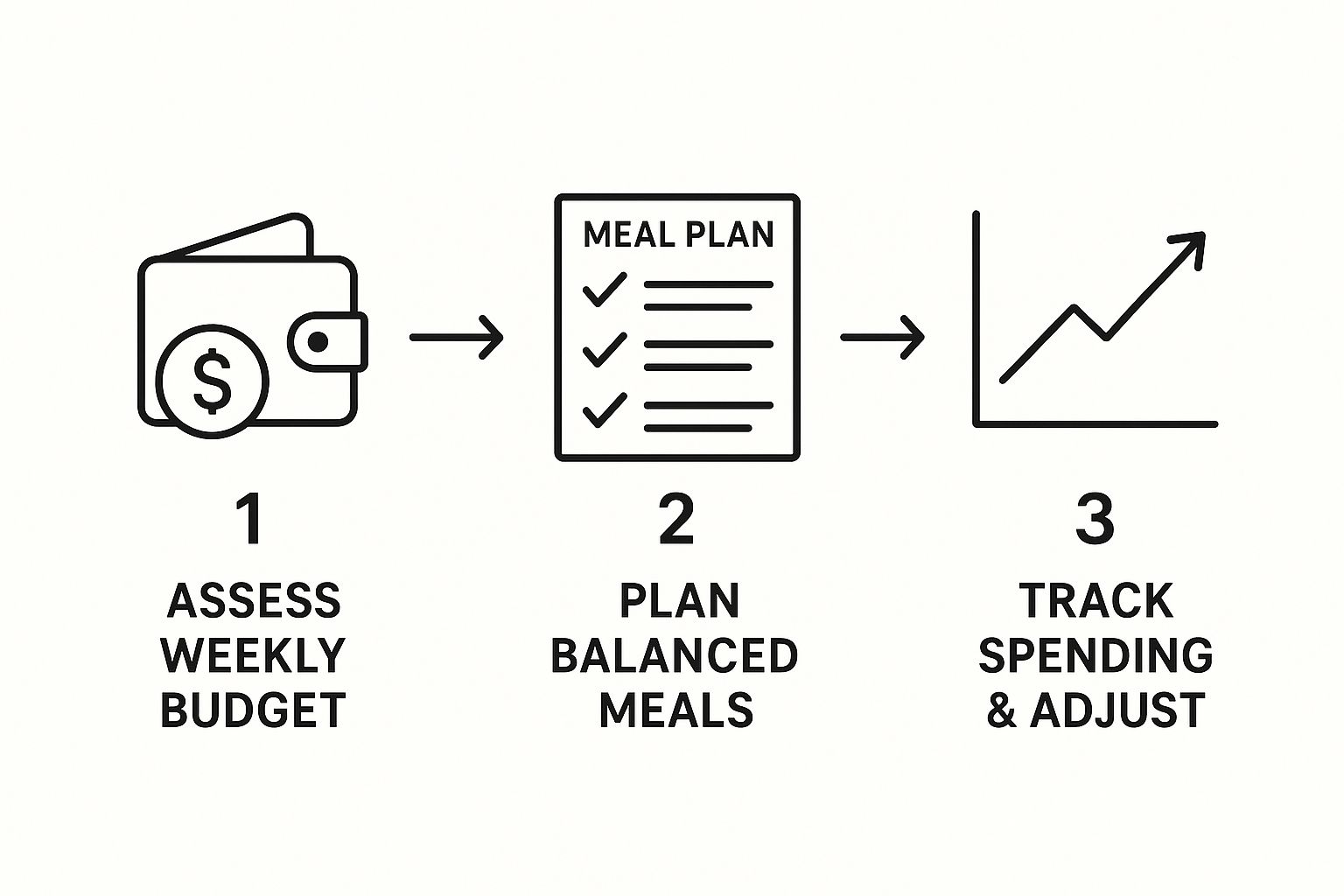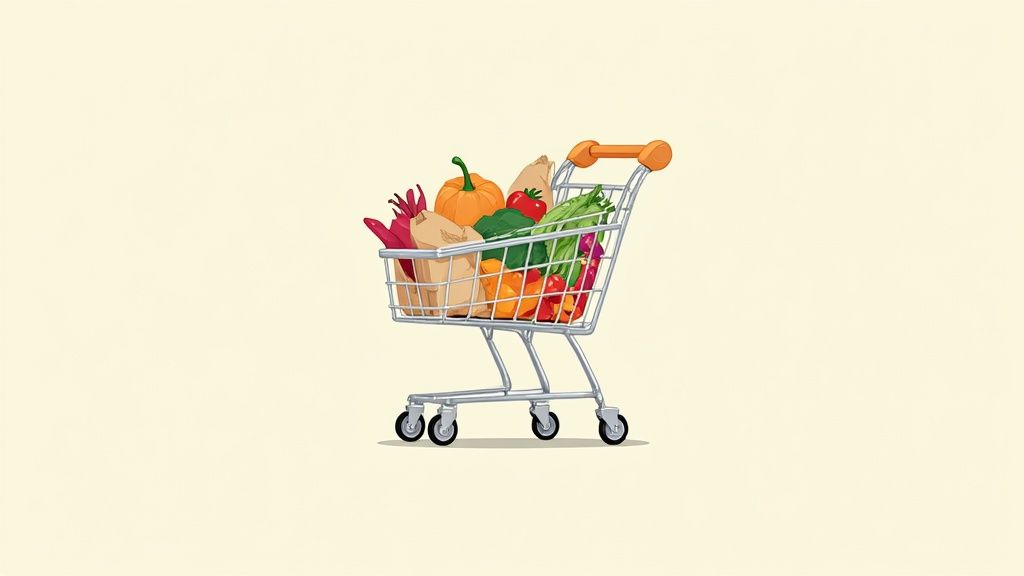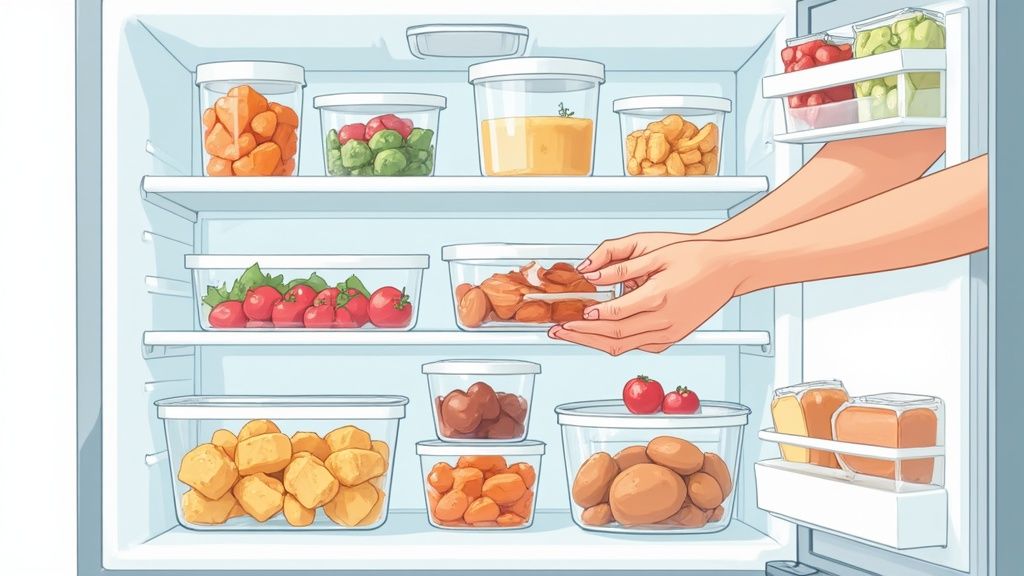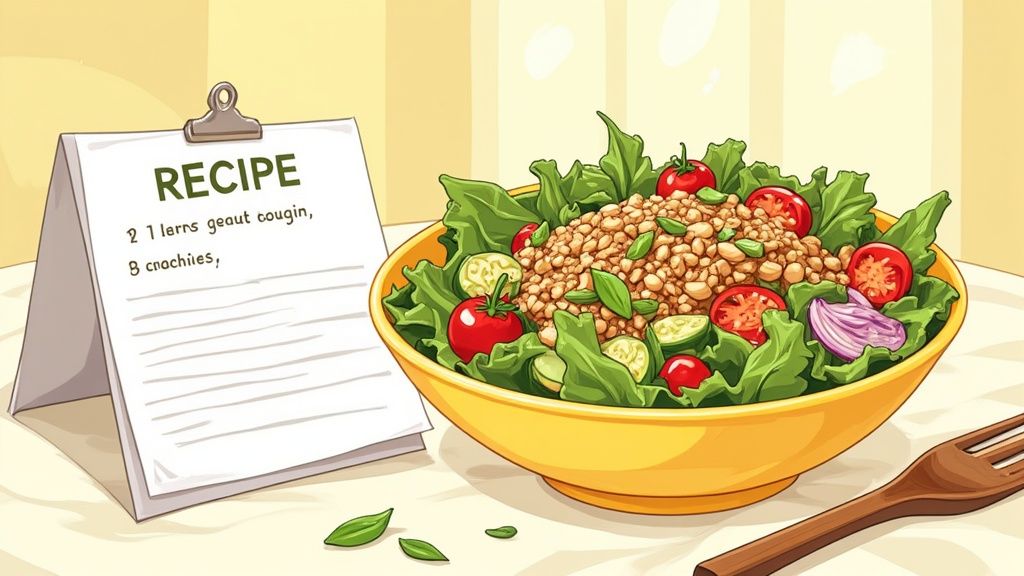Healthy Meal Planning on a Budget Guide

Diving into healthy meal planning without breaking the bank can feel overwhelming, but it really just boils down to having a solid game plan. It all starts with setting a realistic food budget, stocking your pantry with affordable staples, and creating a go-to list of simple, low-sugar meals. This initial setup is what gets rid of the daily stress and stops those expensive, last-minute food purchases.
Starting Your Budget-Friendly Food Journey
Deciding to eat healthier on a budget is one of the best changes you can make for yourself. This isn't just about saving cash; it's about creating sustainable habits that will nourish you for years to come. The whole point is to build a little structure to avoid that nightly "what's for dinner?" panic—the one that usually ends with an expensive and unhealthy takeout order.
First things first, you need to know where you stand. Before you can set a realistic budget, you have to get an honest look at what you’re already spending on food. This isn't about judging yourself, it’s just about collecting information. Spend one week tracking every single dollar that goes toward groceries, takeout, coffee, and snacks. You’ll probably be surprised by what you find.
Set a Realistic Food Budget
Once you have a clear picture of your spending, you can set a goal that actually works for you. A good budget isn’t about starving yourself; it’s about being smart with your money. And trust me, you can eat incredibly well on a tight budget.
Believe it or not, some super-savvy planners have figured out how to eat a healthy diet on as little as $42 per week. They do it by focusing on nutrient-rich staples like potatoes, whole chickens, frozen veggies, and eggs. It's totally possible when you plan ahead.
Here's a sample breakdown of a weekly food budget and the essential pantry items to start with.
Sample Weekly Budget and Core Pantry Staples
| Category | Example Budget Allocation | Core Pantry Items |
|---|---|---|
| Produce | $12 (focus on seasonal & frozen) | Onions, garlic, potatoes, frozen berries, spinach |
| Protein | $15 (eggs, beans, whole chicken) | Canned tuna, dried lentils, chickpeas, eggs |
| Grains | $5 (buy in bulk) | Brown rice, whole-wheat pasta, oats, quinoa |
| Pantry & Dairy | $10 (milk, yogurt, canned goods) | Canned tomatoes, coconut milk, olive oil, spices |
This is just a starting point, of course. You can adjust the numbers and items based on what you and your family actually eat.
A great way to stay organized and ready for anything is to build a core pantry list. These are the versatile, long-lasting ingredients that serve as the foundation for dozens of different meals.
- Whole Grains: Brown rice, quinoa, and oats are your best friends. They're filling, packed with nutrients, and super cheap when you buy them in bulk.
- Legumes: Canned or dried beans, lentils, and chickpeas are protein powerhouses. Use them to make meat go further or as the star of the show.
- Canned Goods: Having canned tomatoes, tuna, and coconut milk on hand means you're always just a few minutes away from a quick sauce, soup, or curry.
- Frozen Produce: Don't sleep on the frozen aisle! Frozen fruits and veggies are just as nutritious as fresh, but they’re often cheaper and last way longer, which means less food waste.
Creating this "recipe bank" of go-to dishes is a key part of building healthy habits that stick. When you have a handful of reliable, low-sugar meals you can make from your core pantry, you're less likely to fall back on old patterns.
This early planning phase is what really sets you up for long-term success. If you want to take your savings to the next level, you could even try growing some of your own produce. This simple guide on how to start a garden for beginners is a fantastic resource to get you going.
Building a Smarter Weekly Meal Plan
Alright, you’ve got your budget sorted out. Now for the fun part: putting that plan into action. If there's one single strategy that makes the biggest difference in eating healthy on a budget, it's creating a weekly meal plan. This is where your goals stop being abstract ideas and become a real, practical roadmap for the week. No more guesswork, no more impulse buys.
The first habit I always recommend is deceptively simple: shop your pantry first. Before you even dream of a grocery list, take a quick look at what you already have. Seriously, check the fridge, the freezer, the cupboards. That half-empty bag of lentils? The lonely can of crushed tomatoes? That’s your starting point for a cheap and tasty meal right there.
It’s a small step that stops you from buying things you don't need and forces you to use up what you have before it goes bad. It's a direct hit against food waste.
This visual lays out a simple cycle for effective weekly planning—from checking your budget all the way to tracking what you spend so you can get even smarter next time.

As you can see, this isn't a one-and-done task. It’s a continuous loop where you learn and refine your approach with each passing week.
Overcome Decision Fatigue with Themes
One of the biggest reasons people fall off the meal-planning wagon is the sheer mental effort it takes. "What's for dinner?" can feel like a high-stakes question every single night. To make it easier on yourself, try assigning themes to different days. This little trick is a game-changer for cutting down on decision fatigue.
Here’s what that might look like:
- Meatless Monday: A great way to lean on affordable plant-based proteins. Think hearty lentil soup, black bean burgers, or a chickpea curry. All are filling and incredibly cheap.
- Taco Tuesday: Use ground turkey, shredded chicken, or even seasoned black beans as your base. Any leftover toppings can be tossed into a salad later in the week.
- Stir-fry Friday: This is the ultimate "clean out the fridge" meal. Grab whatever veggies are left from the week, throw them in a pan with some rice or noodles, and you’re good to go.
Maximize Every Ingredient
Smart meal planning is all about making every dollar stretch. The real secret is learning to see how one core ingredient can anchor several different meals. This is how you really slash waste and get the most out of your budget.
Let’s take a simple roast chicken, for example. It’s the gift that keeps on giving:
- Night 1: Enjoy a classic roast chicken dinner with a side of roasted potatoes and green beans.
- Night 2: Shred the leftover meat for tacos, or pile it on top of a big salad for a quick lunch.
- Night 3: Don't throw out that carcass! Use it to make a simple, nourishing chicken broth, which becomes the base for a fantastic vegetable soup.
Planning for leftovers isn’t just about saving money; it’s about saving time. When you make chili or soup, intentionally cook a double batch. You’ve just guaranteed yourself a healthy, ready-to-go lunch for the next day, which helps you sidestep the temptation of pricey takeout.
This kind of strategic thinking is more important than ever. In 2024, the average global cost for a healthy diet was $4.46 per person per day, a price tag billions of people simply can’t afford. Making every ingredient count is a practical way to manage food security in your own home. For more on this, you can find some eye-opening insights about global food affordability on Worldbank.org.
Navigating the Grocery Store Like a Pro
Alright, you've got your shopping list. Now, let's turn that grocery store trip from a chaotic dash into a strategic mission. It’s easy to get sidetracked by flashy endcaps and tempting displays, but a little planning goes a long way.
The first trick I learned was to ignore the store's intended path. They almost always want to funnel you through the middle aisles first—the land of pricey, processed foods loaded with sugar. Don't fall for it.
Instead, make a beeline for the perimeter of the store. This is where the real food lives: fresh produce, dairy, eggs, and lean meats. Sticking to the outer loop naturally fills your cart with the good stuff first, leaving less room (and less budget) for junk.

This one simple habit helps build your meals around whole, nutrient-dense ingredients, sidestepping all those packaged goods with hidden sugars and preservatives. It’s a game-changer.
Decode Prices and Find True Value
Don't let a bright yellow "SALE!" tag be the only thing that catches your eye. The real key to saving money is looking closer at the unit price—that tiny print on the shelf tag showing the cost per ounce, per pound, or per item. A bigger box might seem more expensive at first glance, but it often has a lower unit price, making it the smarter buy.
Getting comfortable comparing unit prices is like having a secret weapon for your food budget. It helps you see past the marketing and understand the real value. This skill is even more powerful when you pair it with smart label-reading. For a deeper dive, check out our guide on how to read nutrition labels.
And don't forget the freezer aisle! It's another spot where value is hiding in plain sight. Frozen fruits and veggies are picked at peak ripeness and flash-frozen, which locks in nutrients. Sometimes, they're even more nutritious than fresh produce that's traveled for days. They’re usually cheaper and last for months, which is a huge win for cutting down on food waste.
Focus on Budget-Friendly Powerhouse Foods
The cornerstone of eating healthy on a budget is building your meals around inexpensive, filling staples. Some foods just give you an incredible amount of nutritional bang for your buck.
Here are a few of my go-to's:
- Legumes: Whether you buy them dried or canned, beans, lentils, and chickpeas are protein and fiber superstars. They keep you full for hours and cost just pennies per serving.
- Eggs: At roughly 20 cents an egg, they are one of the most affordable and versatile high-quality proteins you can buy.
- Root Vegetables: Potatoes, carrots, and sweet potatoes are cheap, loaded with vitamins, and incredibly versatile. Roast them, mash them, or throw them in a soup.
"I challenged myself to create a month’s worth of dinners using simple, budget-friendly ingredients—and spent only about $45. These meals are easy and feature filling, nutrient-dense staples like beans, lentils, and rice."
By making these powerhouse foods the foundation of your meals, you’re guaranteeing a week of satisfying and affordable eating. A successful grocery run is less about what you buy and more about the smart, strategic choices you make in every aisle.
Making Meal Prep Work for You
Let's be honest, meal prep can sound like a total drag. Who wants to spend their entire Sunday chained to the kitchen? But here's the secret: it's not about that. Effective meal prep is your superpower for staying on track, especially when life gets chaotic. We’re talking about a manageable, two-hour session that sets you up for an entire week of success.
The real goal here is to do the heavy lifting upfront. That way, when you stumble in the door on a Tuesday night, a healthy, delicious meal is just minutes away—no expensive, sugar-laden takeout required.

Think of it as a gift to your future, frazzled self. This simple habit is the absolute cornerstone of any successful plan for healthy meal planning on a budget.
Start with Simple Batch Cooking
You don't need to cook five different complicated recipes to win at meal prep. The smartest way to start is by batch-cooking versatile ingredients you can mix and match all week long. This keeps things interesting and saves a ridiculous amount of time.
Here are a few of my go-to starting points:
- Get your grains on: A big pot of quinoa or brown rice is incredibly useful. It can be the base for a power bowl, a hearty salad, or a simple side for your protein.
- Roast a huge pan of veggies: I love to chop up whatever's on sale—broccoli, sweet potatoes, bell peppers, onions—toss them with a little olive oil and seasoning, and roast until they're perfect. You can throw these into everything.
- Prep your protein: Grill a pack of chicken breasts, hard-boil a dozen eggs, or simmer a batch of lentils or black beans. Having these ready to grab makes assembling a meal almost effortless.
With this "component prep" method, you avoid the dreaded meal-prep burnout. One night, you might have a bowl with that quinoa, chicken, and roasted veggies. The next day, you could shred the same chicken for a quick wrap with some fresh spinach. See? Flexibility is key.
Assemble Grab-and-Go Meals
For breakfasts and lunches, having fully assembled meals ready to go is a game-changer. It completely eliminates that morning scramble and kills the temptation to buy a sad, overpriced sandwich at noon.
A few easy ideas to get you started:
- Overnight Oats: Just mix rolled oats, your milk of choice, some chia seeds, and maybe a tiny bit of maple syrup in a few jars. Pop them in the fridge, and breakfast is done for the next few days.
- Mason Jar Salads: This is a classic for a reason. Pour your dressing in the bottom, then layer hard veggies (like carrots or cucumbers), your grains, protein, and finally the leafy greens on top. This clever trick keeps everything from getting soggy.
- DIY Snack Packs: Forget the vending machine. Portion out some almonds, baby carrots, and a scoop of hummus into small containers. It's the perfect way to beat the 3 p.m. slump with some real energy.
A quick pro-tip: good storage is everything. I highly recommend investing in a decent set of airtight glass containers. They don't get stained or smelly like plastic, and you can pop them right in the microwave. Fewer dishes are always a win in my book.
Dedicating just a couple of hours one day a week can completely transform your week. You’ll eat better, feel less stressed, and save a surprising amount of money by avoiding those last-minute food purchases. It's a powerful habit that truly makes all the difference.
Using Simple Tech to Stay on Track

Sometimes the biggest challenge isn't the cooking—it's the mental load. Juggling a budget, a meal plan, and a shopping list can feel like a part-time job. This is where a little bit of tech can make a huge difference, taking the guesswork out of the process.
The right apps don't just organize your plan; they become your partner in crime. When you're focused on cutting back on sugar, a tool like the StopSugar app is a game-changer. It’s not just about logging what you eat. It helps you see the connection between your sugar intake and your mood, which is a powerful motivator to stay on track.
Weaving Apps into Your Weekly Routine
Think of these tools as your digital kitchen assistants. The trick is to find one or two that genuinely make your life easier and fold them into your regular planning session.
A smart digital workflow can completely change your week. Here’s what that might look like:
- Find Your Meals: Use an app to discover new low-sugar recipes, especially ones that use ingredients you already have on hand.
- Build Your List: As you pick your recipes for the week, the app can automatically generate a shopping list. No more scribbling on scrap paper!
- Share the Load: Most list apps let you share with a partner or family member. Now anyone can add to the list or tackle the grocery run.
This simple system keeps everyone in the loop and means you're far less likely to get to Wednesday night and realize you forgot the main ingredient for dinner. To get a better handle on the financial side of things, exploring the best money-saving apps can also give your budget a serious boost.
The payoff for using this kind of tech is real. A 2025 survey found that 72% of people who used meal planning apps consistently saw improvements in their physical and mental health. These tools were also shown to boost adherence to nutrition goals by 58% and save people an average of 3 hours per week. That’s three hours you get back for yourself.
Think about it: when your meal plan is a dynamic, digital checklist, you offload the mental burden of remembering every little thing. That frees up your mind to focus on what matters—actually cooking and enjoying healthy, delicious food.
At the end of the day, these tools offer more than just convenience. They provide the structure and support that are so essential for turning good intentions into habits that actually stick. If you want to dive deeper, check out our guide on the https://stopsugar.app/blog/best-habit-tracking-apps to find more tools to keep you motivated.
Of course. Here is the rewritten section with a more natural, human-written tone.
Got Questions? Let's Talk Real-World Meal Planning
Look, even the most perfect plan runs into real-life hurdles. When you’re trying to eat healthy and save money, things are going to come up. So, let's tackle some of the most common questions I hear from people trying to make this work.
"I Have Zero Time to Cook. How Can I Possibly Eat Healthy on a Budget?"
This is probably the biggest challenge for most of us. The secret isn't magically finding more hours in the day—it's about being smarter with the time you do have. Think simple, low-effort meals and strategic prep.
I swear by what I call "component prep." Just set aside one hour over the weekend. In that time, you can batch-cook a versatile grain like quinoa, chop up foundational veggies like onions and bell peppers, and grill a few chicken breasts. That one hour of work makes weeknight cooking incredibly fast.
Here are a few other tricks I rely on:
- Sheet pan dinners are your best friend. Seriously, just toss your protein and veggies on a pan with some seasoning and roast. It’s a game-changer.
- Put your slow cooker to work. It does the cooking for you while you're at work or running errands.
- Don't shy away from healthy convenience foods. A can of rinsed black beans, a bag of frozen broccoli, or a store-bought rotisserie chicken can be a lifesaver.
The point isn't to turn into a gourmet chef overnight. It's about making healthy food the easiest, most convenient choice you have, even when you're exhausted.
"What Are Some Good Low-Sugar Snacks That Won't Break the Bank?"
Snacking is where good intentions—and budgets—often go to die. My advice? Skip the fancy, pre-packaged "health" snacks. They’re usually overpriced and loaded with hidden sugar anyway. The best snacks are the ones you put together yourself from simple, whole foods.
Think about it: a hard-boiled egg gives you fantastic protein for about 20 cents. A handful of almonds from the bulk bin will keep you full with healthy fats and fiber. Some of my other go-to's are apple slices with a spoonful of natural peanut butter, plain Greek yogurt with a few berries, or baby carrots and hummus. And if you want something crunchy, pop your own popcorn at home—it's ridiculously cheap and way healthier than the bagged stuff.
"My Family Is So Picky. How Can I Get Them on Board?"
Ah, the picky eater. This can be a tough one, whether it's your kids or a partner who's stuck in their ways. The trick here is to focus on involvement, not enforcement. You have to give them some skin in the game.
Try letting each person in the family pick one healthy meal for the week. You'd be surprised how much this one small thing can shift their attitude. Another great tactic is serving "deconstructed" meals, like a taco bar where everyone can build their own with healthy toppings.
And remember to introduce new foods slowly, right alongside old favorites. Don't try to overhaul everything at once. Be patient—it really is your best tool. It takes a little while for taste buds and old habits to catch up.